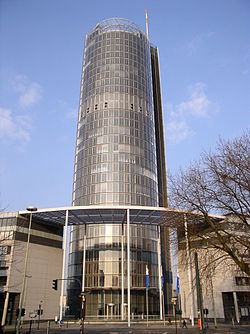Niederaußem Power Station
History
Initial construction

In the autumn of 1960 the construction work for the blocks A and B (150 MW) began. The location was selected because of the possibility of an extension. The supply of brown coal was ensured by seams on a north-south course ("Garzweiler"). Before blocks A and B first produced power, the construction work for the first 300-megawatt power station block location in Niederaussem began. That block went online in the summer 1965. Between 1968 and 1971, three further blocks with improved technology were developed. With the building of the two 600 MW blocks, a large jump forward occurred. These blocks were synchronised to the grid in 1974. At that time, the blocks at Niederaussem produced a total of 2,700 megawatts.
Mid-1990s
In the middle of the 1990s, the output was again increased. In order to reach the limit values of the new environmental protection regulations, in 1986 the work for a flue-gas desulphurization plant began. That work was completed in 1988. The flue gases are fed into scrubbers and cleaned by a lime-water mixture. The cleaned and cooled exhaust is then warmed up to 75 °C (167 °F) again and carried by the chimneys to the outside air. During the flue gas purification, gypsum from the lime-water mixture, which is processed beside the power station in Auenheim by the company Pro mineral, is produced.
1997 to present
With the construction of the new BoA block (Braunkohlekraftwerk mit optimierter Anlagentechnik), German for lignite power station with optimised system technology, a new chapter at the power station began; between 1997 and 2002 it was the most modern brown coal power station block of the world with a gross production of 1,012 megawatts (950 MW net) with a far higher efficiency (43%) than most other plants (as low as 31%). RWE invested €1,200 million into the project. The new power block building has a height of 172 metres (564 feet) and is the tallest industrial building in the world. The new unit's cooling tower was also the tallest in the world at 200 meters (656 feet) when it was built, but is now the third-tallest, after those at the Pingshan Power Station in China and the Kalisindh Thermal Power Station in India. Thanks to these developments, Niederaussem became one of the largest and most modern coal-fired power stations in the world. The official opening of the new block took place in summer 2002.
Since 21 July 2006, RWE has spent €40 million building a fluidized bed drying unit with waste heat technology as a pilot project for the drying process of the raw brown coal. In addition, the free waste heat of the power station is used.
The older units at the plant are being decommissioned starting in the early 2010s. Units A and B were decommissioned at the end of 2012. In 2019, RWE cancelled a 1,200 MW upgrade. Unit D was decommissioned on 31 December 2020, and unit C was decommissioned a year later on 31 December 2021. Units E and F were decommissioned on 31 March 2024.
2006 fire
On 9 June 2006 at 1:15, a fire caught hold in block H of the coaling station. The fire spread to two further coaling station blocks. Later, the flames seized nearly the entire area of the "old power station", and a large, black smoke cloud ascended, which spread many kilometers to the north-west. The power station's own fire brigade could not control the fire and sounded the alarm. About 300 rescue forces from the entire Land responded. The damage to property went into the tens of millions. Even by the late evening of the next day, the fire was not completely extinguished. The spread of the fire was contained by recently-developed fire precautions in the other sectors of the power station so that only the coaling station was affected.
See also
- List of power stations in Germany
- List of tallest cooling towers
- North-South industrial spur
- Neurath Power Station
- List of least carbon-efficient power stations
References
- ^ Grant, Don; Zelinka, David; Mitova, Stefania (2021). "Reducing CO2 emissions by targeting the world's hyper-polluting power plants". Environmental Research Letters. 16 (9). doi:10.1088/1748-9326/ac13f1. ISSN 1748-9326.
- ^ "HEAL Lignite Briefing" (PDF). Retrieved 2019-07-14.
- ^ "List of least carbon efficient power stations", Wikipedia, 2024-01-15, retrieved 2025-01-18
- ^ "Boilerhouse of Unit K of Niederaussem Power Plant, Bergheim - SkyscraperPage.com". skyscraperpage.com.
- ^ Harte, R; Krätzig, W. B (1 January 2002). "Large-scale cooling towers as part of an efficient and cleaner energy generating technology". Thin-Walled Structures. 40 (7): 651–664. doi:10.1016/S0263-8231(02)00018-6.
- ^ "RWE cancels plans for new coal plants, including Niederaussem". Reuters. 26 April 2019. Archived from the original on May 2, 2019.
- ^ "RWE Power legt weitere fünf Kraftwerksblöcke endgültig still und setzt Kohleausstieg fort".


